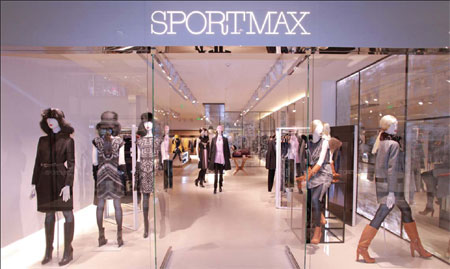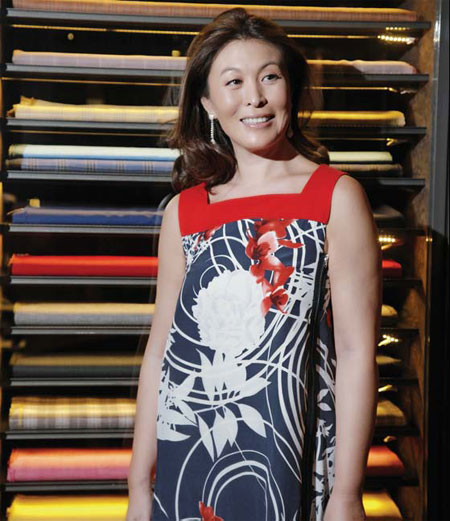Pushing to the Max
Updated: 2012-09-28 10:32
By Yao Jing (China Daily)
|
|||||||||||

|
Top: Sportmax opens its first store in Beijing at the Shin Kong Place in August.Above: Linda Hong Lin, president of Beijing-based GBMax Ltd, a joint venture of the Max Mara Fashion Group, says she wants to bring more Italian goods to China. Photos Provided to China Daily |
Italian fashion house aims to strengthen foothold in China while others may totter
When other luxury fashion companies are feeling the chill in China, the Max Mara Fashion Group, one of the first on the scene 13 years ago, is putting the heat on with plans for a major expansion.
A disappointing profit outlook from luxury goods sellers has heightened concerns that slowing growth in China threatens to stifle booming upmarket fashion businesses as they head into the crucial holiday season.
But with 250 stores in the Chinese mainland for its seven brands, the Italian fashion house is planning to double that amount within the next five years.
The Italian fashion house aims to have 520 stores in China by 2017.
"We will focus on second and third-tier cities as we have secured the market share in big cities such as Beijing and Shanghai," says Linda Hong Lin, president of Beijing-based GBMax Ltd, a joint venture of the Max Mara Group and Lin's former trading company.
Since she helped open the first store in Beijing's China World Mall in 1999, and brought Italian fashion into China, Lin has gone from being a distributor to a direct manager of the label.
Based on its successful performance in China, the company decided to form a joint venture with Lin's company in 2009.
Commenting on the label's achievement in China, Lin says that apart from the advantage of marching into the market earlier than others, the label has been conducting a multi-brand strategy in China to build different images to communicate with consumers.
Target consumers for Max Mara labels range from teenage girls to women over 60.
"Flagship brand Max Mara became the first label to the China market when I got the distribution rights from the headquarters in Italy in 1999," Lin says.
China contributed less than 10 percent of the group's total global revenue before 2010. But because of rapid expansion since 2008, it is now nearly 15 percent, Lin says.
Raised in Rome, Lin bought the classic Max Mara camel-color overcoat with her first paycheck after graduation. When she traveled on numerous occasions to China in the 1990s, as an assistant to the owner of an Italian trading company, she saw few fashion products in China.
"The idea of introducing Made-in-Italy to China came to mind," she says. "As Max Mara was the most popular brand in Italy, and I saw a link between the brand's design and Chinese people's tastes, I decided to fight for the brand's distribution rights."
Despite her current success, the beginning in China was a hard one for both the brand and Lin.
Lin says the brand is more suitable for professional women and most of the Chinese consumers at that time were conservative in clothing.
"Few people knew the brand, and most of the Chinese consumers had little knowledge about fashion," she says. "It was also difficult for us to locate the stores as the number of real high-end shopping malls was so limited."
The situation began to change in 2003 when the rising middle class in China started to show more interest in brands and luxury goods.
The average price for a piece of Max Mara clothing is 10,000 yuan ($1,590, 1,220 euros) and its famous overcoat sells for between 20,000 and 30,000 yuan.
From 2003 to 2008, an average of 10 new stores were opened each year to meet a year-on-year growth rate in turnover of nearly 70 percent.
The annual growth rate is now about 20 percent.
As Chinese taste in fashion gradually changed to come in line with Western countries, Lin and the group found opportunities to introduce other lines, such as Max&Co, Pennyblack, Marella and Iblues, to the market.
In Beijing's first Sportmax store, opened last month, the new collection focuses on the cultural and Zen elements of traditional Asian martial arts. New suits or sweaters with rhomboid patterns embroidered entirely in micro sequins alternate with leather waistcoats.
"I think this is the right time for us to bring the more boldly designed brands here," Lin says.
Ren Guoqiang, a partner of Roland Berger Strategy Consultants, who specializes in consumer goods, says: "Building a flagship brand in the market and then conducting the multi-brand strategy is very helpful in developing sales channels. Assembling brands in one place can also impress consumers and help increase sales."
But Ren queries the promotion tactics in China of what he regards as a very low-key label.
"I think Chinese consumers are not as mature as those in Western countries," he says. "Consumer guidance and brand advertising are very important at the current stage."
For further development of the fashion house in China, Ren suggests it should pay more attention to the likes and dislikes of Chinese women.
"Women are always more picky in buying clothes. As a professional women's brand, it cannot rely on the brand's fame in its country of origin, but must cater to local consumers' tastes."
Lin says the label's promotion is in line with the headquarters' global strategy, and her responsibility is in operations such as employee training and marketing.
With the increasing appeal of the label in the market, more new-built shopping centers are wooing the label.
"But we have strict standards in choosing a store site," Lin says. "As for the Max Mara brand, we are not allowed to locate it in a store that is less than 300 square meters in size."
The market has also changed a lot, she says.
"Consumers do not place as much emphasis on brand now. They now have new requirements about quality and the mix-and-match concept is popular. Logo is not regarded as necessary to revealing identity."
Overall, Lin says the market is not as tolerant and inviting as it was five years ago, and luxury and fashion newcomers from Europe and US should not look at China as a lifesaver.
"Companies with a turnover of less than 100 million euros ($128 million), or some family-owned ones, should think carefully in terms of marketing, managing, sales channels and etcetera," she says.
At present, Lin flies back and forth to Italy every two months.
"I want to bring more Italian goods to China, but I will never play the role of an agent because I think an agent's fate is always unsure."
yaojing@chinadaily.com.cn
(China Daily 09/28/2012 page19)
Today's Top News
Rescuers race against time for quake victims
Telecom workers restore links
Coal mine blast kills 18 in Jilin
Intl scholarship puts China on the map
More bird flu patients discharged
Gold loses sheen, but still a safe bet
US 'turns blind eye to human rights'
Telecom workers restore links
Hot Topics
Lunar probe , China growth forecasts, Emission rules get tougher, China seen through 'colored lens', International board,
Editor's Picks

|

|

|

|

|

|






